Math Reasoning Exercise: Set 3 - Questions 6 to 10
Question 6
Identify the pattern. Then identify the next number
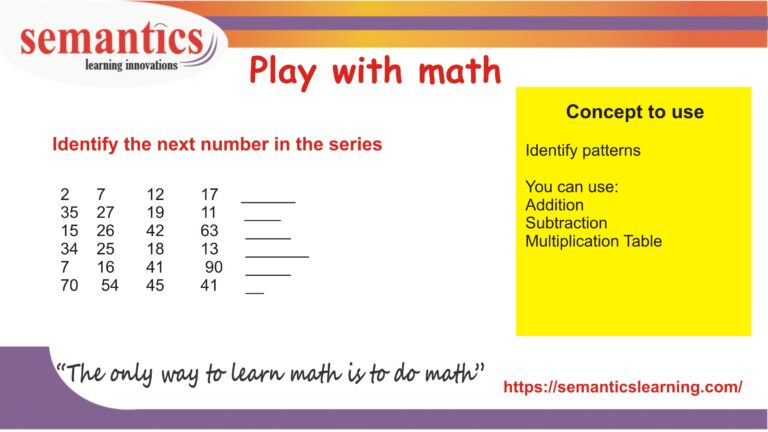
Logic:
1. The numbers are added with 5. The next number is 22
2. The numbers are subtracted by 8 The next number is 3
3. The differences of the numbers are increasing by (26-15) 11, (42-26)16 (63-22) 21 ,. The next number is 63+26 =89
4. The differences of the numbers are increasing by odd squares (16-7)9, (41-16) 25… The next number is 171
5. The differences of the numbers are squares in decreasing order (70-54)16 (54-45) 9 . Next number is 40
Question 7 & 8
Identify the pattern. Then identify the next number
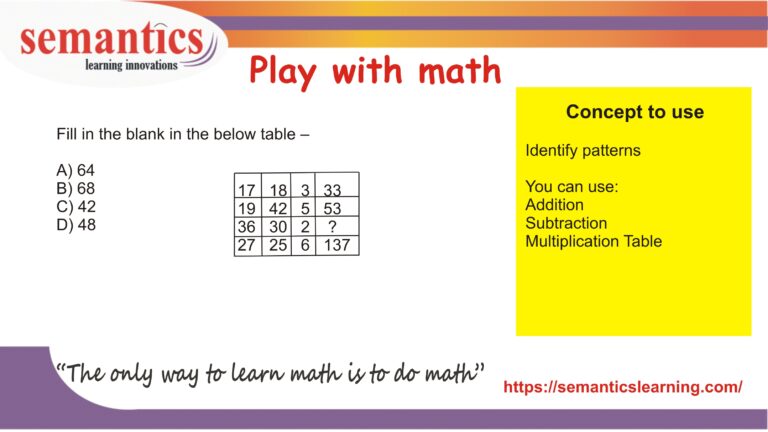
Logic: In Row 1 – Number in col 1 x Number in col 3 – number in col 2= number in col 4
The pattern which emerges
17 x 3-18 =33 19 x 5-42 = 53 27 x 6-25 = 137.. So 36 x 2-30 = 42
Now, lets make more questions like this
First lets analyze the last problem.
In this grid there are a sequence of numbers.. you need to identify the missing number in the grid.
To solve these type of sums you need to analyse the numbers either rowise or columnwise. And then establish an equation relating the numbers.
First you have to analyse the numbers in row 1 and see if they can be related to form an equation.. Then you need to analyze the numbers in column 1.
Once you get the equation, then you have to check if others numbers follow the same pattern..
So for this sum the logic/equation is:
In each Row – Number in col 1 x Number in col 3 – Number in col 2= Number in col 4
Then you have to check for each row whether this equation fits.
- 17×3-18 =33
- 19 x5-42 = 53
- 27×6-25 = 137
- So 36×2-30 = 42
Now follow the steps to make your own math question…
Step 1: Think of any logic..
It can be
In each Row – Number in col 1 x Number in col 2 – number in col 3= number in col 4
Or
In each Row –Number in col 2 + Number in col 1 / number in col 1= number in col 4
You can also do it rowise.
In each column –Number in row 1 / Number in row 2 + number in row 3= number in row 4
or
In each column –Number in row 2 x Number in row 3 + number in row 1= number in row 4
Make sure, the equation has numbers either from a row or from a column. Don’t take numbers from a random row and a random column. Don’t mix numbers .
Use any math operation in between the numbers ( addition, subtraction…..)
Step 2: Generate numbers in the grid.
- Easy level – single/double digit numbers
- Medium level – 3+ digit numbers
- Hard level – using more math operations( power, cube root, square root….)
Make sure the answer is an integer. There should be no fractions or decimals
For example
Logic: Number in col 1 + Number in col 2 / number in col 3= number in col 4
5+7/2 = 5+3.5 =8.5. 8.5 is a decimal.
You should get only integers. So chose appropriate numbers.
Step 3: Use BODMAS to ensure you follow the correct order of operations.
As per the order
- First operation is Division
- 2nd operation is Multiplication
- 3rd is Addition
- 4th is Subtraction
To calculate 3 x 2 +5 =
First do multiplication then do addition
So 3×2 = 6 then add 5.. Hence answer is 11
You should not do this way 2+5 = 7 then multiply 3. You will get 21.This is wrong. because multiplication has to be done first, then addition
Follow the order to get the correct answer.
Step 4: Remove a number
After you fill the grid. Replace any number with x .. and your question is ready..
Now make your own question.. Let your imagination run wild!
Happy learning.
I made one
Logic – In each column –Number in row 1 / Number in row 2 + number in row 3= number in row 4
10/2 + 3 =5+3 =8.
This is the complete grid

Now Remove any one digit..
and your question is ready

Question 9
Try these problems. Use rules of counting. You can do these sums using matchsticks.

First to understand the problem. Try with 7 matchsticks and 10 matchsticks. Count how many squares you can form
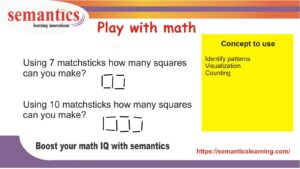
With 7 you can make 2 squars.
With 10 you can make 3 squares.
You are placing the squares in a linear fashion.
In our question. You are asked to form maximum number of squares. If you place them linearly you can form squares.
If you make a grid 2×2. You can form maximum number of squares as 4 small squares make 1 big square. So you will get 5 squares. We are using the principles of counting which we discussed earlier.
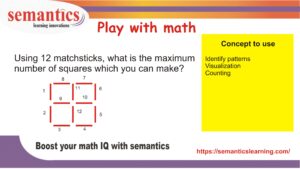
Question 10
Fill in the blanks with missing math operations
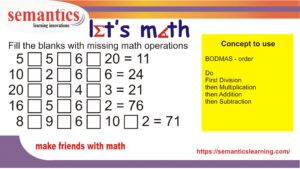
Answers:
- 5 x 5+6-20 = 11
- 10/2 x 6-6 = 24
- 20-8/4+3 = 21
- 16 x 5-6+2 = 76
- 8 x 9-6+10/2 = 71
